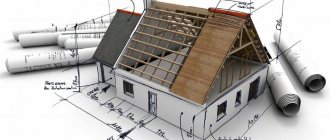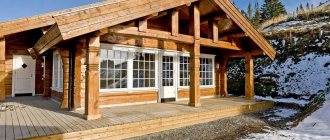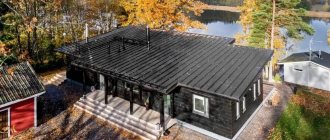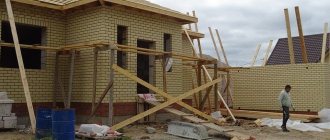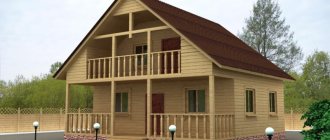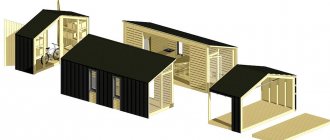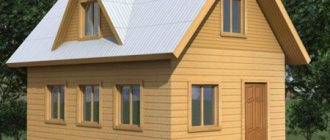Maintenance and operation costs after construction
The main cost item when operating a log house is ensuring the tightness of the walls. The cracks that appear during drying must be caulked. Houses built using Russian logging technology require caulking 2-3 times a year for 10 years after completion of construction. Caulking is the process of filling the resulting cracks with heat-insulating materials - tow or jute fiber. This is a very labor-intensive task that requires special skills. Accordingly, the cost of work will be very high. The use of putties and sealants when caulking is unacceptable, since the process of natural air exchange in the layers of wood is disrupted, this leads to increased humidity and the development of mold and mildew.
Canadian logging does not provide for additional caulking of walls during the shrinkage process. A layer of insulation is placed in the crowns during construction; if the construction technology is followed, the walls reliably retain heat even in the harshest winter. Thanks to the special shape of the bowl, the dried upper log is tightly connected to the lower one, forming a monolithic joint that does not require additional insulation. This is why Canadian log houses are often not lined from the inside, while heat loss is kept to a minimum.
Canadian logging involves the use of round planed logs of coniferous wood as a building material for the manufacture of log houses. The wood used for these purposes is one whose wood is endowed with a dense structure and unsurpassed quality.
Scheme of processing logs using Canadian felling.
Canadian logging technology is actually a variation of Russian, since it originated in ancient times in our country. Even if we recall the traditional dwellings of the indigenous people of Canada (Eskimos from the north, Indians from the south), there is a clear external difference from a log hut. The name appeared much later than the Canadian logging itself. Having originated here, the technology did not take root in Russian spaces. In Canada, on the contrary, it gained particular popularity and began to be used everywhere, which is why it acquired its current name.
The corners in a wooden frame are most susceptible to rotting. This is due to the fact that in the traditions of Russian cutting “in the oblo” it is customary to place the bowl bottom down. Due to this, storm water easily penetrates into the bowl, which absolutely cannot happen when cutting in Canadian style.
All over the world today, felling of log houses is carried out using the Russian-Canadian technology “into the bowl”. The buildings erected using this technology are distinguished by reliability and entertainment, durability and practicality. Private construction of wooden log houses for baths and houses is gaining momentum. But in our country, Canadian technology is not considered widespread due to the insufficient number of craftsmen to implement it. Much more often they use the usual Russian cutting.
This is interesting
Despite the fact that this cutting method is called Canadian, many experts believe that it was most likely invented many centuries ago by Russian Pomors. After all, this technology was brought to Canada from Europe. And most of the cutting methods that exist in this part of the world were borrowed from the Pomors. In Russia, a method of felling “in the saddle” that is quite similar to the Canadian one is still practiced. When using it in logs, cheeks and bowls are also selected and ground.
Canadian cutting of bathhouses and residential buildings has recently gained increasing popularity. After all, this technology makes it possible to build truly high-quality and at the same time very durable structures. Living in such houses is comfortable both in summer and in winter, and they actually look very prestigious.
You can buy a house made of cedar by choosing one of the kit options
in the car Price includes
- felling of a log house (work and materials);
- marking the log house and dismantling the log house before loading;
- loading bathhouse elements into vehicles for transportation along the route Sayanogorsk - the Customer’s foundations.
on the foundation
The price includes:
- works and materials included in the “In the car” package;
- work and lumber for the installation of “independent floors” on the Customer’s foundations;
- assembly of the log house on the Customer’s foundations;
- metal fasteners;
- interventional insulation;
under the roof
The price includes:
- Works and materials included in the package “On the foundation”
- work and lumber for the installation of a rafter system
turnkey
B can take responsibility and build a turnkey house and bathhouse. The cost will largely depend on the construction of the foundations, the choice of finishing materials for floors and roofing, as well as equipment for life support.
Project of a log house made of Ontario cedar logs
The project of a log house made of cedar logs was implemented by us in the Moscow region. If desired, you can change the layout of the house according to your needs.
Construction and felling of a log house "Ontario"
Stages of house construction work:
- felling a log house in Siberia takes approximately 2-3 months depending on the time of year
- transportation of the log to your foundations - 12 days
- assembly and construction and finishing work - 4-6 months
The cost of felling includes the design of door and window openings, fitting of ridges and ridges below the level of the slope, openings for hidden jacks in the pillars.
LOG PROCESSING:
- Debarking and planing with eder. This method allows you to preserve the natural curvature of the log and gives a wild style to the log house.
- During felling at a work site in Siberia, grooves and bowls are treated with Neomid antiseptic. At the end of the felling, the entire log house is treated with a transport antiseptic for 5-6 months.
- Upon completion of the assembly of the log house and installation of the roof, as a rule, sanding of the logs and coating with a permanent antiseptic or oil is required.
Bathhouse made of cedar "Babik". Price, equipment and construction stages
- Seal
Thanks to manual cutting, the highest quality is achieved, which cannot be achieved when processing logs using other methods. It is during manual processing that the log ideally retains its qualities - warmth, durability, natural beauty, resistance to environmental influences.
Characteristics of a log bathhouse made of cedar "Babik" | |
| wood type for log house |
|
| log diameter |
|
| log cutting technology |
|
| sauna size |
|
| transportation of logs (number of vehicles) |
|
Types of logs used
Don’t think that the technology is a one-size-fits-all solution with no possibility of making adjustments. The greatest space for individual choice is provided by the variety of the main material - logs. Or rather, methods of preparing wood. It must be said that Canadian technology requires considerable investment in building materials, so there will be an opportunity to save money. However, you should start with the optimal solution for those who do not want to skimp on quality. In this case, you should prefer a scraped log. This material preserves the natural shape of the surface, which also increases the aesthetic advantages of the log house. The drawing of the crowns in such a design is carried out with minimal tolerances, duplicating the complex shape of the elements.
The option of planed logs is no less attractive. All external flaws and defects of the log are smoothed out, thereby simplifying the drawing process. This is a durable and high-quality processed log, which is inferior to the scraped one only in aesthetic advantages. If you plan to cut log houses in Canada with minimal investment, then it is worth using a planed log, the drawing of which is carried out in one approach. However, the tolerances of “bowls” with grooves in this case increase, which may require caulking.
The history of the appearance of Canadian logging
In the mid-18th century, Russian settlers brought this technology to Canada. The local population (Indians and Eskimos) did not know this method of building wooden houses.
In Russia at the same time, architects preferred faster and less labor-intensive cutting methods. Arriving in Canada, Russian craftsmen were forced to adapt Russian cutting to local conditions, sacrifice speed and simplicity, giving preference to reliability and thermal efficiency.
Now Canadian log houses are popular not only in North America and Canada, but also in other countries, including Russia.
Canadian house projects: exterior
Wooden buildings look very impressive if a technology such as Canadian felling was used in their construction. Photos of houses built using this technique clearly demonstrate their solid and stylish exterior. The sizes of buildings of this type can vary, just like their layout. There are projects of both one- and two-story Canadian houses. Very often the emphasis in the exterior and interior of such buildings is on glazing. Sometimes even pediments are mounted completely transparent. In this case, supports are used from the same log from which the walls are made, placed vertically.
Large forms are what distinguishes Canadian logging. Projects of houses built using this technology therefore often involve the use of the same massive decorations. For example, in combination with a thick log, natural stone masonry looks very aesthetically pleasing. Therefore, very often Canadian houses are supplemented with various kinds of elements built precisely from this material: supports, built-in barbecues, fireplace chimneys above the roof, etc. The foundations of such buildings are often built from rubble stone. Sometimes it is used simply for external finishing of the base of a structure.
In most cases, Canadian timber houses are finished using a special, “breathable” acrylic impregnation. In this case, both completely transparent compositions and slightly tinted ones can be used. For example, a reddish-colored impregnation gives a very interesting effect. After treatment with this material, the wood acquires a noble dark shade.
Various types of architectural additions are also used in the construction of Canadian houses - balconies on massive supports, bay windows, terraces, etc. The parapets of such elements can be figured.
Cutting methods “with residue” and “without residue”
When making a log house using the “residue” method, or cutting “into a bowl”, a recess is cut out in the logs, and the next log is placed in it. With this, the logs protrude beyond the walls by a certain distance (25 cm on average). Thus, the material consumption increases at the rate of 50 cm for each log in the log house. Such costs are offset by good protection of the corners of the log house from wind and rain. It is believed that such a log house is superior in stability to other construction technologies. If the logs are processed carefully and efficiently, the building looks attractive and even decorative; moreover, it does not require either external or internal wall decoration. This cutting method has many varieties:
- Russian cup,
- canadian cup,
- Norwegian cup
- German cup and others.
Today, the “Norwegian castle” and “Canadian cup”
Of the many known methods for constructing classic log houses, there are two technologies for cutting log houses that allow you to avoid the appearance of cracks when the house shrinks and do without constant caulking.
Advantages
It is profitable to build houses and baths with “ROYAL CEDAR”! Only we:
- We carefully select building materials. We have a production site and logging plots. We don't buy timber, we cut it ourselves in the Siberian taiga! Each tree is inspected by a master with twenty years of experience and checked with an ultrasonic flaw detector. For construction, blanks with good indicators of curvature, density and resin content are used. Our logs have no visible or hidden defects. Unsuitable specimens are rejected and used for lumber production.
- We develop detailed projects. The sketch part is a sectional view of the frame, a layout with an explication of the premises and a foundation plan. All documents necessary for production are contained in the constructive section: cutting maps for all types of lumber, diagrams for laying crowns and wall layouts. All design documents are created automatically, which eliminates errors. Our log houses are cut in strict accordance with design developments, and each item in the estimate can be justified with documentation.
- We hire the best carpenters and finishers. We build turnkey houses and bathhouses. We do not involve subcontractors in our work; we carry out all design, construction and finishing work ourselves. Our staff employs the best Siberian carpenters and all-round finishers, so we are confident in the result. All work is our guarantee!
- We offer prices from the manufacturer. Projects from ROYAL CEDAR contain documents that allow you to save: cutting maps for wall material and specifications for all lumber. We are manufacturers and do not work with intermediaries. Our Customers pay only for the material and work of our craftsmen. Remuneration for intermediaries and resellers is not included in the construction budget.
Material selection
Canadian house logging involves the use of logs that meet specific standards. Experts insist on using logs with a diameter of at least 30 cm at the top. This condition must be met due to the specifics of shrinkage and shrinkage of the entire log structure. A larger diameter can be used at the request of the customer - the thicker the log, the fewer crowns are needed for a log structure, which, of course, will have a positive effect on preserving the heat of the future home. The thick log guarantees thermal insulation of the corner cups.
The length of the logs used can be 14m. During the construction of walls that exceed this parameter in length or according to design needs, joining can be done using screw ties. In addition, the junction must be covered with a transverse wall of the cut. It turns out that for large-area projects, using different lengths of harvested logs, it is possible to erect buildings of any shape and size
It is important to choose the right logs in terms of quality, diameter and length
In the process of building wooden cottages using Canadian logging, only coniferous wood is used. This is due to the high resistance of coniferous wood to environmental humidity. Such a house will not be subject to destruction either in wet weather or in rain or snow. This wood contains a lot of resins; in addition, it has a high density.
Can be used:
- pine It is traditionally used for the construction of log houses. The level of its resin content and high density guarantee the durability of the structure, and the attractive amber shade of the timber makes it possible to leave the cottage without cladding
- larch. Its strength is 30% higher than that of pine. The level of resin is also higher, so it is more resistant to damage by microorganisms. This wood is a good option for baths
- cedar (cedar pine) is a natural antiseptic. Since ancient times, people have noticed that this wood improves the health of those who live in the house
- spruce
- Canadian red cedar.
What are the differences from Norwegian cutting
Similar climatic conditions in Scandinavia and Canada also led to many similarities in approaches to construction. Therefore, the two technologies have more similarities than differences. For example, both methods allow you to form a dense, self-wedging frame. Canadian cutting, like Norwegian cutting, is done without the use of nails, so the responsibility of the architects designing such a house increases.
But there are also significant differences. The main one is the use of large logs, the diameter of which can reach 50 cm. In the case of a Norwegian log house, a well-prepared carriage is more often used. Another distinguishing nuance lies in the technique of forming corners. North American builders use “saddle” cutting, which precisely ensures the tightness of the fit of the logs. Largely due to this feature, Canadian log house cutting is more popular. A photo with an example of fitting logs is presented below.
Layout
Canadian houses are designed so that living in them is as comfortable as possible. A spacious hall is added to the corridor. Living rooms in buildings of this variety are often large and very well lit due to the presence of large windows. Of course, inside a Canadian house there are all the elements generally inherent in log buildings: visible massive stylish beams, wide staircases with reliable railings, original stoves or fireplaces.
Diamond bowl or Diamond edging
- Construction of houses in a diamond bowl requires high skill from carpenters, because this is a very complex technology. The difference from the usual Canadian method is the number of stitches - they are performed not on one side of the crown, but on two:
- A large number of edges intersect in the cuts, which outwardly resembles a diamond. This is where the name of this method comes from, with the help of which you can emphasize the natural shape of the butts and the beauty of the wood texture.
- Tightly fitted (up to a millimeter) corner joints of the crowns are considered the pinnacle of the craftsmanship of hewers.
- The advantages of a diamond bowl are the same as those of a regular Canadian one: complete tightness and no cracks after the frame shrinks.
- The only drawback of diamond cutting is the reduction in the width of the thermal groove. It is for this reason that it is advisable to choose this type of felling when a wooden house is being built from logs with a diameter of more than 460 mm. In large log houses, diamond cutting looks especially elegant!
Arrangement of the bathhouse
The ceilings in the steam room of a Canadian bath should not be very high. A hood must be provided. In addition to the wash room, steam room and dressing room, there is usually a relaxation room. Often Canadian baths are built with an attic and a wide terrace, decorated with massive railings. Doors and windows in such buildings are often mounted on blocks, without the use of a frame.
Benches can be assembled on beams, but more often they are also made massive, with log supports and seats made of very thick boards. A massive table and chairs can be installed in the relaxation room.
Canadian felling: technology features
- Canadian cutting combines the characteristic features of Russian and Norwegian styles. Large diameter logs are suitable for construction, which are carefully adjusted to each other when assembling the structure.
- Carpenters make a special “lock”: a tenon is cut out in a wedge-shaped bowl in the lower crown, and a trapezoid-shaped bowl is cut out in the upper one. Under the weight of the logs, during shrinkage, the fastening becomes tightly jammed, thereby achieving complete tightness of the “lock.”
- Full matching of the bowls in shape and self-jamming of the “lock” minimize the risk of the connections opening over time. Atmospheric moisture does not penetrate inside the corner. The insulation located in the grooves retains its natural properties for a long time.
- Using Canadian technology, logs are cut on both sides at an angle of 45 degrees. The length of the notch is equal to twice the diameter of the log.
- For Canadian log houses, logs processed with a stapler are used. This tool allows you to very carefully debark the workpiece, leaving the sapwood intact. Such logs look original, and log houses made from them last a long time.
- The grooves are made with an adze, the wood is hewn along the grain. This allows you to clog the pores and resin channels. This “preservation” increases the service life of wood.
- For Canadian logging, it is recommended to use logs with a diameter of 400 mm or more. We build from cedar, pine and larch with a diameter of up to 700 mm.
Material selection
For the construction of a hand-cut Canadian house, round logs with a diameter of 30-60 cm are used. Since the quality of wood is the “foundation” of the durability of the future house, they undergo careful selection at the stage of purchasing raw materials. After this, the selected forest comes to our base, where in specially prepared places it undergoes preparatory processing, which is divided into two stages:
- stage - sanding. This is the removal of bark using a scraper or a sharpened shovel. It is worth noting that this must be done quickly enough to prevent the process of rotting and the spread of the bark beetle. For example, it takes 2-2.5 months to build a log house with an area of 100 sq/m, but the 1st stage of raw materials is completely completed within the first two weeks from the moment they arrive at the production site.
- stage - sharpening with an electric planer. The purpose of this treatment is to remove remaining bark and give the trunk a more aesthetic appearance. In this case, contrary to popular belief, not the entire protective layer is cut off, but only a small part of it. For example, a tree trunk with a diameter of 30 cm has a protective layer of 5-6 cm, but only 3-7 mm is cut off. After sharpening, each log is treated with a special antiseptic to protect and preserve it for the entire construction period until the final painting of the log house at the customer’s site.
If during the preparatory processing process traces of blue staining, rot, or any other previously invisible negative defects are discovered, then such material is also rejected partially or completely and goes into the production of recycled materials.
And only after going through all the above procedures and receiving final approval, the material arrives at the assembly site.
Canadian log castle
The castle of the Canadian log house has the shape of a trapezoid. Trapezoidal cuts are made on the lower log. The same shape is repeated on the walls of the castle bowl of the upper log. The Canadian Bowl is made using a chainsaw.
The "Canadian Bowl" is hand-selected. The bowl is removed in such a way that after laying it on the lower log there is no gap between the castle bowl and the log. The peculiarity of Canadian logging is its maturation. The log house is cut and assembled on the manufacturer's premises. A log house takes 12-18 months to mature.
During maturation, the log house goes through two stages. The first stage is drying. When drying, gaps form between the logs and in the locks. At the second stage, the log house settles. During the settling process, the gaps disappear, and the lock seems to be “pulled” onto the log, making the connection very tight.
After dismantling the frame and assembling it locally, insulation is placed in the castle bowl. This additionally seals the frame, and what is typical is that the seal remains invisible, and the walls of the frame do not require re-caulking.
The “Canadian bowl” log house is distinguished by a variety of castle connections. Let me give you an example of such a complex castle. This lock has a wedge. The wedge is cut in the upper lock. A groove is cut in the lower lock, into which a wedge is inserted during drying.
DomiTy.ru
Other articles in the section: Log houses
- How to assemble a chopped log house when selling
- Stages of construction of a log bathhouse
- How much does a log house weigh: estimated weight of a log house
- Assembling a log house using moss: why moss is considered better
- Do you know the features of a Russian log house?
- What is a handmade wooden house
- Choosing wood for a log house
- Rounded logs: production and dimensions
- Types of log houses depending on the type of timber
- How to caulk a log house: description, tools, caulking technologies
New articles
- General technology for building a house from timber
- Do-it-yourself log caulk
- Winter felling of a log house, what is it?
- Log bathhouse
- Loghouse lock: types of loghouse locks, types of corner notches
Features of the technique
Canadian houses are assembled using a technology similar to our Russian “in a bowl”. That is, a groove is selected in the lower log for the upper one. In this case, the edges of the logs are brought out. This allows you to make the corners of the house as warm as possible. The differences between technologies such as manual Canadian cutting and Russian cutting are as follows:
- In the shape of the bowl itself. In Russia, the groove is traditionally made semicircular - according to the shape of the log itself. The Canadian bowl is formed from oval cheeks cut out on the sides of a log, located at a certain angle. In this case, the bowl turns out not oval, but trapezoidal.
- In the thickness of the log. When constructing log houses in Russia, material with a cross-section of 20 cm or more can be used. If Canadian logging is used, the logs must have a diameter of at least 50 cm.
- In the method of erecting gables. When assembling a house using Russian technology, they are sheathed with boards. In a Canadian house, the gables, as well as the walls, are usually assembled from logs. In this case, segments of different lengths are simply used.
Canadian houses can be assembled from either regular or hewn logs. In the latter case, processing is done manually. In this case, it is necessary to remove the bark as carefully as possible. Thus, the main layer of wood of the log remains intact. Therefore, this material, unlike rounded material, fully retains all its advantages.
Types of wood for a Canadian home
To assemble a durable frame, you need to select a type of wood that will have increased performance characteristics.
To assemble a durable frame, you need to select a type of wood that will have increased performance characteristics. Considering that the climate in Russia is moderate, and winters can be quite severe, it is necessary to select logs made from northern cold-resistant wood species. The most commonly used are coniferous varieties. The following are especially popular:
- Siberian pine. An excellent option for building a log cottage. Pine logs have an affordable price in tandem with optimal technical characteristics. Harvested in the cold season, pine logs have a high density and minimal humidity, which contributes to a small shrinkage of the finished log house. In addition, pine releases valuable phytoncides into the atmosphere, which have a beneficial effect on health, and in particular the respiratory system of household members. Pine logs retain heat well, resist water and are not susceptible to rotting. In addition, pine is easier to process manually.
- Larch. More expensive building material, but also more durable. Larch logs are particularly dense, making them more difficult to work with than pine. But larch logs are resistant to moisture. Moreover, under the influence of water, larch becomes even stronger and denser. It is worth noting that this moisture-resistant type of wood does not rot for many years, which has a positive effect on the strength of the entire structure. The price of larch logs is several times higher than pine, which makes it less in demand. Most often, larch is used as a material for the backing board and the lower crown of the log house.
Spruce logs are mainly used to construct internal partitions at home.
- Spruce. This type of coniferous wood has increased fiber. That is why spruce logs, although good for health, are mainly used for constructing internal partitions at home. Because when wet, spruce will open its pores and fibers, absorbing excess moisture. But inside, spruce wood will look unique. The even light shade along the entire length of the round timber and the valuable aromas of the resins that the log will emit inside the house make it quite popular.
- Cedar. It is considered an elite type of wood because it has increased strength and a noble shade. A cedar log means the durability of a cottage and a light cedar aroma in the air of the log house. But the price of a cedar log stops the developer and forces him to use simpler types of wood.
Technology
Canadian felling, the technology of which is excellent when you need a log house with a round log, provides excellent protection from drafts. Also, this type of felling makes it possible not to think about constantly filling up the log house. After all, the technology itself assumes the absence of gaps.
The Canadian log house is built using the tongue-and-groove technology. The groove is a Canadian cup, it faces down, as a result of which additional protection from drafts and moisture is guaranteed. The groove is trapezoidal in shape, and the tenon coinciding with it is wedge-shaped. This is what prevents the cups from opening during drying with the formation of cracks (as in the case of Russian felling), but “jams” the logs one on top of the other. It is worth noting that neither moisture nor air comes into contact with the insulation in the bowl, which means it retains all its properties.
In the process of forming the Canadian cup, double-sided cutting of the log is used at an angle of 45-50 degrees. However, the accuracy of the angle is determined by a specialist for specific logs and adjusted manually. The length of the cut is taken to be two diameters of the log itself (often 60 cm)
It is very important to align the notch lines with the mating line of the cups to ensure the integrity of the logs
To guarantee perfect abutment and “jamming” of the log in the groove and cups during drying, it is worth leaving a special saddle gap of approximately 25 mm. This process is called hanging logs - underwriting or drawing with magnification.
Experts distinguish two types of bowl (lock):
- classic with two tassels at the top
- diamond or diamond notch, which has four notches, two on top and two on bottom. Quite similar to a Norwegian castle, only on a round log.
In Canadian logging there are log releases at the corner joints, which are called “corners”. Such releases are designed in different ways: straight end, along the radius, in a running pattern, figured/curvilinear. The use of log “skirts” in the corners of the butt allows you to give an attractive style to log houses, which emphasizes the uniqueness and natural beauty of natural architecture.
Why is it worth building according to Canadian logging?
There are a number of reasons why it is worth constructing buildings using Canadian technology:
- this method requires builders to select and process each log by hand. Even the planing and sanding of logs has to be done by specialists rather than by machines, which makes it possible to choose the highest quality material and achieve its best condition for construction. Thus, a log prepared for Canadian felling compares favorably with a rounded one
- Heat saving is the basic concept for this technology. For this reason, even cups for insulation and grooves are selected manually to guarantee the most accurate connection
- Due to the peculiarities of fitting logs, it is possible to build a log house in such a way that it looks like a solid mass without joints, gaps, or gaps. The insulation is not visible either from the outside or from the inside, and a second “caulk” is not needed
- Canadian log cutting assumes that during the process of forming walls, the outer layer of wood is not removed, this guarantees the building additional biosecurity and protection from freezing
- The wood layer prevents damage by microorganisms, and also preserves the material from destruction from ultraviolet radiation and burnout. This means that the tree does not change its color under the sun and its properties over time.
- the log retains its natural curves, natural shape and surface structure, thus removing some artificiality from the log house
- Using this technology, a special microclimate is formed in the house, as a result of which the level of comfort and coziness increases. The bathhouse looks very advantageous - Canadian felling makes it possible to preserve the maximum amount of properties of pristine wood for this room.
Assembling a wooden house at the customer's site
Waterproofing is laid on the pre-laid foundation and the lower crown is mounted. According to the markings, logs are laid sequentially to form walls. To prevent the house's frame from being blown through, the insulation channels are filled with flax sealant. Special reinforcing elements are installed in window and door openings and gaps are calculated taking into account the upcoming shrinkage and shrinkage of wooden walls.
To protect the wooden structure from fungus, bark beetle and the harmful effects of the external environment, it is treated with an antiseptic drug. To increase its efficiency, impregnation is carried out three times: during cutting of logs and cutting grooves, after preliminary assembly and during final installation.
Stages of construction of a Canadian townhouse
We produce SIP blocks with the required parameters according to the building design. This allows you to optimize material costs. The construction of a cottage consists of several stages:
- Supply of house components to a personal plot.
- Installation of a strip, column or pile type foundation.
- Assembly of external walls, interior partitions and ceilings.
- Installation of double-glazed windows, door sets and finishing of premises.
basic information
This technology, despite its name, has Russian roots (from the inhabitants of Novgorod the Great), who created colonies in the 15th century. When cutting using the “Canadian bowl” technology, the walls of the building look like a solid mass, while the bowl itself has the shape of a trapezoid.
Figure 1. Comparison of Canadian and Russian logging
The specificity of the joint is the creation of an additional technical groove, which disappears during shrinkage and drying. When building log houses in all countries of the world, there is a big problem: if you do not caulk the cracks, then in winter the house will turn out to be uninhabitable. With a bathhouse, this problem is completely relevant, because... It will be impossible to wash in it, and this is fraught with all sorts of diseases. In Canadian logging technology, this issue is eliminated precisely due to the specifics of creating a lock, which, when dried, brings the tree into an ideally dense state.
If you pay attention to Fig. 1, you can see how the process of shrinking occurs in Russian and Canadian log houses
Russian technology is more chaotic, which is why pressure comes from all sides immediately towards the center, and then the elastic force tries to restore everything back, which is why cracks appear. Canadian felling is a horizontal lateral pressure on the internal element of the lock, due to which the log is slightly compressed and extended vertically, and the remaining resistance freely dampens the compression. Thanks to this, cracking is avoided.
There is also a complication of the lock, which uses a spike (tail tail). Not every craftsman will decide to create such fasteners, but if done correctly, the quality of the joints will increase significantly.
When working, it is very important to make the joints conscientiously, so as not to create an excess groove (no more than 5% of the total height of the log), and also to use really high-quality materials. Deciduous trees are not suitable for building houses even in cases where there are no others nearby
Such a house, even in a treated state, will last no more than 20 years, after which it will require prompt dismantling. It is advisable to choose coniferous trees based on strength, but if there is no experience in this, then by weight (the higher the weight of dry wood, the denser it is).
Story
Despite its name, the technology for constructing log houses called “Canadian logging” is one of the varieties of the so-called “Russian logging”.
It was invented by our ancestors, but it became most popular initially in Canada. The indigenous peoples of Canada, the Eskimos who lived in the north, and the Indians who lived in the south, traditionally did not use the construction of wooden houses in their lives.
It was the Russian pioneers, who appeared in Canada in the mid-18th century, who used this technology to build their usual homes. Since Canadian logging is more reliable for protecting a wooden structure, but at the same time more labor-intensive, it has not taken root in its homeland. While the settlers, thanks to their passion and energy, choosing between the durability of their home and the speed of its construction, chose the first. And it is precisely because of this that this technology has become widely popular in North America.
General information about the technology
This method of forming a house is also called “bowl” cutting. Based on the general characteristics of construction, the technology can be classified as a variety of traditional Russian logging. Moreover, its roots come from Russia, but it has not taken root here, but Canadian craftsmen have improved it and have been using it for decades. Also, modern builders from Russia have taken a different look at the advantages of cutting logs using Canadian technology, and are increasingly using this technique in their work. Among the features of this cutting method, one can note the complexity of the design. If classic log houses are mainly formed using the technique of simple laying of elements, then the installation configuration according to the Canadian method is highly accurate and thoughtful. Of course, it is painstaking installation that ultimately makes it possible to obtain highly durable houses that are not subject to biological destruction processes.
Read with this
- Houses in Russian style: features of architecture and design
- Premium hand-cut houses on a turnkey basis from Gorodles Group of Companies
- All about rounded logs
- Wooden houses from gun carriages from Gorodles Group of Companies
- Houses made of calibrated logs
- Technology: how to polish log logs
- How to properly caulk a log house
- Processing of ends and ledges
- House made of timber or logs
- Pros and cons of Canadian house construction technology
Canadian chopped baths
Of course, not only residential buildings are erected using this technology. Very often, Canadian felling is used when assembling bathhouses. Like residential buildings, they turn out to be very warm and beautiful. Steaming in a sauna built using Canadian technology is a pleasure. But of course, only if it was built according to all the rules. As in any wooden bathhouse, in the Canadian one, the required standards are observed when installing heaters. The distance from the walls of the furnace to the walls of the structure is at least 50 cm. When using protective sheathing, it is 30 cm. A non-combustible base is installed under the furnace. Most often this is galvanized metal sheet.
